This use cases is about a plumbing company which also repairs boilers, central heating, solarpanels, doorlocks, etc. There are three locations throughout the Netherlands. There is one main office and each site employs 20 employees. The employees consist largely of engineers and planners / project managers. There are also some administrators, office managers, sales staff and the director.
The company has three traditional legacy PSTN PBXss, ISDN lines, and each site also has a fiber connection.
Problem description
This use cases is about a plumbing company which also repairs boilers, central heating, solarpanels, doorlocks, etc. There are three locations throughout the Netherlands. There is one main office and each site employs 20 employees. The employees consist largely of engineers and planners / project managers. There are also some administrators, office managers, sales staff and the director.
The company has three traditional legacy PSTN PBX’s, ISDN lines, and each site also has a fiber connection.
Desired situation
- Employees should be able to adjust their reachability by themselves, matching their current situation.
- Callers should be informed about presence status of employees
- Callers should be able to connect to colleages, if they cannot reach the person they are calling.
- Employees should be easily able to subscribe and unsubscribe to a service group. This can be done with a virtual switch.
- In case of emergency and outside opening hours, the caller wants to be able to call service groups. This can be done with a special IVR menu in a nested dialplan.
- One easy to manage platform for all branches and to dial as much as possible via voip instead of mobile contracts.
Solution
Numbers and devices
- A general number is used (one for each site) and also direct numbers for all employees (including engineers).
- For each of these numbers the same dial plan is used. (see below)
- The engineers work with iPhones in a dust and water proof case. The bria softphone is used, connected via LTE/4G to Compass.
- Other employees can choose whether they work with their smarthphone, a fixed desk phone or a hybrid scenario.
Dial plan
- To create a professional feeling towards callers and inform about presence, prossionally recorded sound prompts are being used.
- Queue’s are used to deliver calls to departments. In some cases, calls are going directly to the secretary.
- To inform callers who are calling outside working hours or in holidays, nested dialplans are being used. In nested dialplans emergency IVR’s are used to have the option to connect to service groups.
- Service groups are internal numbers (extensions) with virtual switches, were employees are able to login or logout from a service group.
- IVR Menu’s are used for callers to choose the right department and for alternative destinations when certain employees are not available.
User settings
- Employees can set their call forward’s in such a way, that if they are not able to quickly answer the call on their desk phone, the call is automatically forwarded to their cell phone. This is usefull in situations were engineers are driving or they have a bad internet connection.
- Employees can use DND (Do Not Disturb) on their desk phone, so they are not disturbed.
- Engineers can use the mobile compass app to chnage a switch to login or logout from a service group.
Dial plan for general number
| Opening and option 1 | Option 2 and 3 | End dial plan |
|---|---|---|
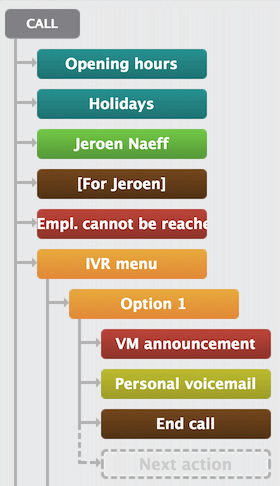 |
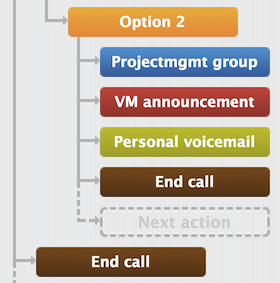 |
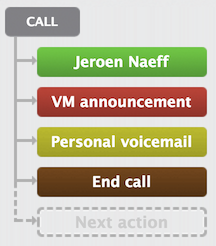 |
- Nested dial plan. The dialplan starts with a forward to the nested dialplan ‘Opening hours’. This nested dialplan also inludes an IVR option for urgent calls, which bypasses closed hours. After this nested dialplan, the call goes through a second nested dialplan, which checks wether it’s a holiday or not. Should it be a holiday, a special prompt will play, ending the call with yet another option for urgent calls followed by a voice mailbox. Please look at the legend for an explanation about forwards and nested dialplans.
- IVR Menu. Next, the caller will hear an IVR menu. Option 1 is the reception, option 2, support and ongoing projects, option 3 is the administration.
- Other elements (under the IVR options). Read the legend for the description.
Dial plan for direct numbers
| Opening and option 1 | Option 2 and end dial plan | Direct internal number |
|---|---|---|
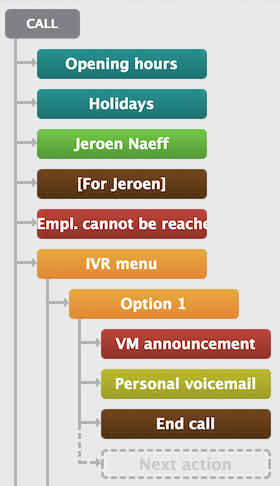 |
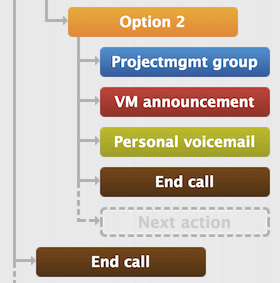 |
 |
- Forwards. The dialplan starts with the nested dialplan ‘Opening hours’. This nested dialplan also inludes an IVR option for urgent calls, which bypasses closed hours. After this nested dialplan, the call goes through a second nested dialplan, which checks wether it’s a holiday or not. Should it be a holiday, a special prompt will play, ending the call with yet another option for urgent calls followed by a voice mailbox. Please look at the legend for an explanation about forwards and nested dialplans.
- Prefix and prompt. When the user doesn’t answer the call (with # to accept enabled), the call gets a prefix with the name of the user and the calller gets notified with a prompt.
- IVR Menu. Next, the caller will hear an IVR menu. Option 1 is the voicemailbox, option 2, coleagues via the projectmanagement queue.
- Other elements (under the IVR options). Read the legend for the description.
